After reading the EB1a visa overview and gaining a general idea of what an EB1a green card petition is, the next step is to learn about what a person would need to provide as evidence to prove that they are qualified for an EB1a green card. The article below provides a brief overview on what the EB1a green card requirements are looking for and what documents are usually submitted for each requirement.
- 1.
- a.
- b.
- c.
- d.
- e.
- f.
- g.
- h.
- i.
- j.
- k.
- l.
- 2.
- a.
- b.
Table of Contents
In an EB1a green card petition, the person would need to show that they have extraordinary ability at a national or international level by either receiving a major internationally recognized award/prize in their field of expertise OR by satisfying at least 3 of 10 criteria listed in C.F.R. § 204.5(h)(3). The person must also show that they plan on continuing to work in the same area of expertise listed in their EB1a green card petition when they enter the United States with their approved green card.
The following sections consist of a brief summary on each requirement and the documents that are generally used as evidence to satisfy that requirement.
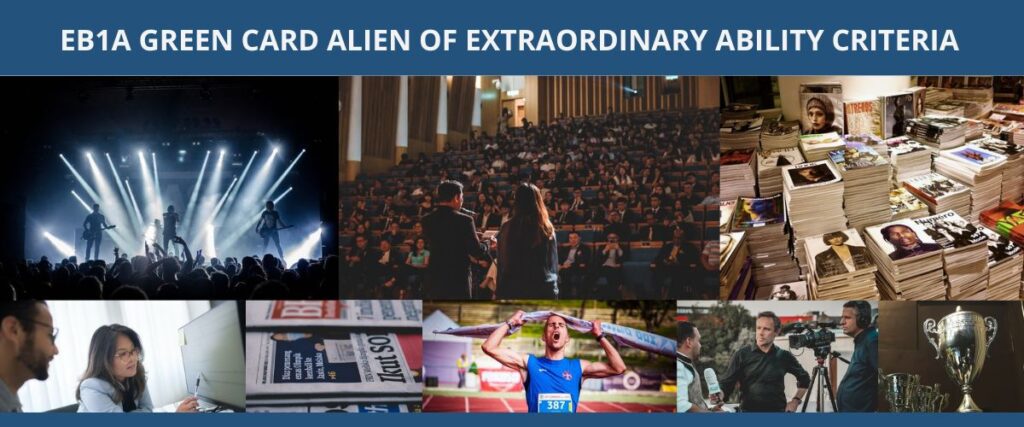
The person will continue to work in the same area of expertise that was used as the basis to apply for the EB1a green card.
The EB1a green card petition requires the person to show that they will continue to work in their professional field of expertise after entering the United States. There is no requirement in the EB1a green card petition to have a specific employer, however, the person must be able to show that they will continue to work in the same area of expertise that they listed in the EB1a green card petition. This is usually done by providing documents that show the person has prearranged commitments in the United States to work in their field of expertise. For example, a contract between an actress and a movie production company stating that she is hired to play a role in an upcoming movie can be used as evidence for prearranged work in the United States.
Documents to Prepare (Continue to work in same area of expertise)
Commonly used documents to prove that a person will continue to work in the same area of expertise listed in an EB1a green card petition includes but is not limited to:
- Employment contracts
- Letters from current or prospective employers
- A detailed statement from the person describing how they plan to continue working in the same area of expertise in the United States
The person received a one-time major internationally-recognized award or prize.
The EB1a green card petition requires the person to prove that they have extraordinary ability in the field of sciences, arts, education, business, or athletics and one of the two ways to do so is to provide evidence to show that the person has been given a major internationally-recognized award or prize before.
A one-time “major internationally-recognized award/prize” under the EB1a green card petition must be well-known on an international level as one of the top awards/prizes in the person’s field of expertise. In other words, the major internationally-recognized awards/prizes are usually household names that the general public would immediately recognize as the highest honors in the field. For example, the Oscars (Academy Awards), Pulitzer Prize, Nobel Prize, Olympic Medals, or a Wimbledon title can be seen as received major internationally-recognized awards/prizes under this EB1a green card petition criterion.
When there are disputes as to whether the award/prize can be qualified as a major internationally-recognized award/prize, factors listed below will be taken into consideration:
- what criteria was used to grant the award/prize
- the reputation of the panel or organization giving out the award
- whether prior winners of the award/prize were internationally acclaimed at the time of receiving the award/prize
- whether there were any substantial cash or non-cash prizes or benefits given to the award winner
- if other internationally well-known people competed for the award/prize
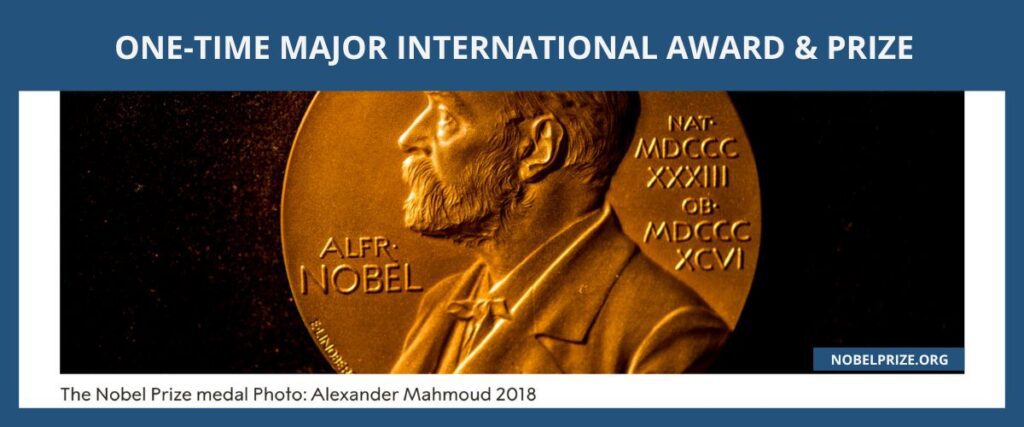
Documents to Prepare (Major Internationally-Recognized Award/Prize)
Commonly used documents to prove that a person has received a major internationally-recognized award or prize under an EB1a green card petition includes but is not limited to:
- A copy of each award or prize certificate
- A clear photograph of each award or prize
- A copy of the public announcement of the issuance of award(s) from the granting organization
The person satisfies at least 3 of 10 criteria listed below:
The EB1a green card petition requires the person to prove that they have extraordinary ability in the field of sciences, arts, education, business, or athletics and one of the two ways to do so is to provide evidence to show that the person satisfies at least 3 of the 10 criteria listed in the C.F.R. § 204.5(h)(3).
The person has received (lesser-known) national or international awards or prizes for achieving excellence in their field of expertise.
One criterion to prove the person has extraordinary ability under the EB1a green card petition requires the person to show that they have been given (lesser-known) national or international awards or prizes in their professional field before.
The “lesser-known national or international awards/prizes” under the EB1a green card petitions are awards or prizes that are known nationally or internationally but with a lower standard than the “major internationally-recognized awards/prizes” which are usually awards or prizes that are household names known by the general public (e.g., Nobel Prize, Pulitzer Prize, Olympic Gold Medal, and the Academy Awards).
Lesser-known national or international awards/prizes under the EB1a green card petition could be well-known in one part of the world or in a specific country but not as well-known in another part of the world or country. For example, the Golden Horse Award and the Mnet Asian Music Award (MAMA) are both awards well-known in Asia but not in the West.
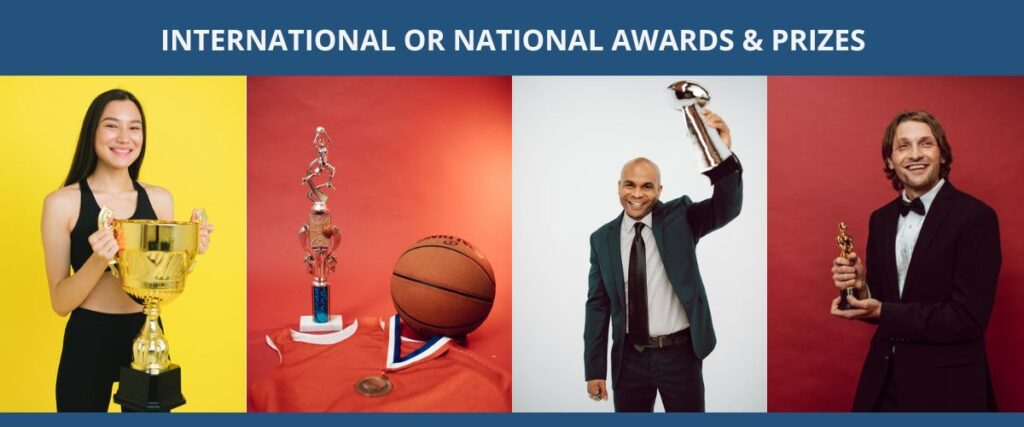
Effective and Qualifiable Items (Lesser-Known National or International Awards/Prizes)
Below are some general guidelines as to what usually satisfies the “lesser-known national or international awards/prizes” criterion under an EB1a green card petition.
- The award here must be nationally or internationally known. International awards may not necessarily be seen as “internationally recognized” simply because more than one country competed for the award. The emphasis of this criterion is on how well-known the awards received are. Legislative history and AAO (“Administrative Appeals Office”) rulings also hold weight in the determination of how certain awards are categorized.
- The award here must be under the same field of expertise that the person is using in the EB1a green card petition. For example, a person basing their EB1a green card petition on the grounds that they have extraordinary ability as a gymnastic coach may not necessarily be allowed to use an award they won as a gymnastic competitor. The reason behind this is that being a good athlete does not necessarily mean being a good coach. They are not considered as being in the same area of expertise.
- Individual awards are usually more readily effective than team awards. For example, when a play or program wins an award, it is seen as a result of the collective talent of the director, writer, producer, and the other workers that contributed to the production, and it would have to be proved that the award can be primarily attributable to the person‘s work. On the contrary, if each member of a group receives a statue, such as the Grammys, it can be seen as a recognition of the individual person’s expertise in the field.
Non-Effective Items (Lesser-Known National or International Awards/Prizes)
Below are some general guidelines as to what items are usually considered non-effective or less-effective in satisfying the “lesser-known national or international awards/prizes” criterion under an EB1a green card petition.
- Awards received at the student level, such as university or post-doc awards, competitive post-doc appointments, dean’s list appointments, conference awards, and most awards in junior music or athletic competitions are not effective.
- Academic scholarships and grants, such as university or post-doc grants, fellowships, and scholarships are usually not effective. The reason is that, unlike awards, grants and scholarships are relatively common and they do not show a recognition of past achievements but instead activity that will be undertaken in the future when given.
- Awards given to the person’s employer are not effective unless it can be proved that the basis for the award is directly attributable to the person.
- Local, regional, or provincial awards, such as awards from regional sporting events are not effective.
- Nominations for an award are not effective.
- Certificates from college are not effective.
Documents to Prepare (Lesser-Known National or International Awards/Prizes)
Commonly used documents to prove that a person has received lesser-known national or international awards or prizes under an EB1a green card petition includes but is not limited to:
- A copy of each prize or award certificate.
- A clear photograph of each prize or award.
- A copy of the public announcement of the issuance of awards from the granting organization.
- Media coverage that shows the award/prize has prestige at a national or international level.
- Letter from the award committee describing the number of people that were nominated for the award and the selection criteria for the award winner.
- Other documents (e.g., official documents announcing the award, event programs) that include information such as the significance of the award in the field, the number of awards given out each year, the caliber of previous award winners, the geographic scope of eligible candidates, the reputation of the panel or organization granting the awards should also be provided.
The person has a membership in an association that requires members to have outstanding achievement in their area of expertise as a condition to become a member (judged by national or international expert).
One criterion that proves the person has extraordinary ability under the EB1a green card petition requires the person to show that they are a member in a professional association that approves membership based on whether the person has attained outstanding achievement in the field. The approval of their membership must also need to be determined by a national or international expert in the field.
The admission to the membership would usually require recommendations from members who are already in the association and the membership approval would need to be based on the person having outstanding achievements in their field of expertise. For example, the American Society of Cinematographers (ASC) requires new cinematographers joining the association to have written recommendations by three active or retired ASC members.
Membership to a professional association under the EB1a green card petition should be exclusive and limited to people who have been judged and determined by esteemed peers as having attained outstanding achievements in their field of expertise. Memberships that require little to no effort, such as filling out a form and paying the annual membership fees, are generally not qualifiable under this EB1a green card petition criterion.

Effective and Qualifiable Items (Membership in Association Requiring Outstanding Achievement)
Below are some general guidelines as to what usually satisfies the “membership in an association that requires an outstanding achievement” criterion under an EB1a green card petition.
- The admission to the association must require the use of a higher and more selective criteria and the association must be related to the person’s field of expertise listed in the EB1a green card petition. For example, a baseball player on the national baseball all-star team, a surgeon in the Society of Genitourinary Reconstructive Surgeons, or a cinematographer in the British Society of Cinematographers.
- Outstanding achievements must be an essential condition for granting the membership and this must be judged and determined by national or international experts who are well-known in the field. For example, the National Academy of Sciences only admits 18 people each year as a Foreign Associate and a nomination by an existing member based on the person’s outstanding achievements in producing original research is required.
- A senior-level membership in an association that has several levels of memberships may be qualifiable under this criterion even if the association’s lower-level memberships are completely fee-based.
Non-Effective Items (Membership in Association Requiring Outstanding Achievement)
Below are some general guidelines as to what items are usually considered non-effective or less-effective in satisfying the “membership in an association that requires an outstanding achievement” criterion under an EB1a green card petition.
- Membership cannot be only based on factors such as the person paying the annual membership fee, passing a certain exam, having years of experience in a field, or a required membership for employment in certain occupations (e.g., union membership). For example, a membership in the American Chemical Society (ACS) is not qualified because it only requires a chemical-related degree or work experience and the payment of its annual membership fees to become a member.
Documents to Prepare (Membership in Association Requiring Outstanding Achievement)
Commonly used documents to prove that a person has membership in an association that requires an outstanding achievement under an EB1a green card petition includes but is not limited to:
- Copy of the person’s membership card.
- Copy of the person’s membership certificate.
- Letter from the association stating that the person is a member.
- The section of the association’s bylaws that details the membership criteria for the person’s membership.
- The section of the association’s bylaws that detail the qualifications required of the judges who review the applications of the association’s prospective members.
- Documents that show the judges who review the applications of the association’s prospective members are well-known as national or international experts in their field of expertise.
- Documents that show how the evaluation process is done when reviewing the applications of the association’s prospective members.
- Documents that include information such as the association’s goals, mission, target members, official admission requirements, total number of members, where the person is ranked relatively to other members, the requirements and conditions to maintain membership, and the status of the association in the field.
There is published material about the person in professional or major trade publications, or in other major media publications (e.g., national newspapers, magazines).
One criterion that proves the person has extraordinary ability under the EB1a green card petition requires the person to show they have published material about them and their work in professional or major trade publications, or in other major media publications.
The published material about the person under the EB1a green card petition must include a detailed report of the person and the person’s work, and it must be published in a professional publication, major trade publication, or major media publication. Importance is placed equally on the coverage of the person and the person’s work.
This EB1a green card petition criterion is focused on published materials in reputable publications that provide a detailed report on the person’s road to success or the breakthroughs in the person’s professional work. For example, a published article in the New York Times describing who the person is, how the person developed a certain medicine, and how the medicine is now widely used in hospitals would serve as good evidence for this EB1a green card petition criterion.

Effective and Qualifiable Items (Published Material About the Person)
Major media outlets can include national newspapers and magazines from the person’s home country or well-known outlets such as the Washington Post, CNN, BBC, New York Times, Boston Globe, New York daily News. The emphasis here is whether the publication’s circulation shows a significant amount of national or international distribution.
- Major trade publications can include specific well-known trade publications or websites such as Nature News, National Science Foundation, The Stage, Variety, Backstage, New England Journal of Medicine.
- Published material that does not cover the content of the person’s work but covers the person receiving an award or grant because of their work can be used.
- Media coverage on the person serving as a judge in a high-profile competition in their field of expertise can be used.
Non-Effective Items (Published Material About the Person)
Below are some general guidelines as to what items are usually considered non-effective or less-effective in satisfying the “published material about the person in professional or major trade publications, or other major media publications” criterion under an EB1a green card petition.
- Articles that cite the person’s work should be substantial and not merely part of a list of citations to other work. Listings in a subject matter index or footnote without evaluation, or unevaluated references to the applicant’s work are ineffective. Citations of the person’s work should be accompanied by statements that describe the person as authoritative in that field of expertise.
- The published material cannot only be discussing the person’s employer or the organizations associated with the person – it must focus on the person and the person’s work.
- Articles that merely review the movie or show as a whole and do not mention the person or only mention the person in passing are ineffective. For example, an article about a widely publicized play where the person took part in as an unnamed cast member would not be effective evidence.
- The publications should not be mere reprints of related abstracts or press releases from journals that publish the person’s work. The published content should be written by independent journalists covering details about the person. For example, an events posting on an upcoming exhibition or a simple summary of a show are not effective.
- Marketing material created for the purpose of promoting the person’s products or services are not effective.
- Articles published by new websites, websites with little credibility, or websites that cannot easily be verified of its credibility are ineffective evidence. The number of hits or views on a particular website does not necessarily indicate credibility.
- Local publications are not effective.
- An article focused only on the person’s personal life and not the person’s professional achievements is ineffective evidence. For example, a biographical article that only contains information about the person’s personal life.
- Articles that cover the person in detail but the evaluation is negative or neutral are not effective and may be harmful.
Documents to Prepare (Published Material About the Person)
Commonly used documents to prove that there is published material about the person in professional or major trade publications, or other major media publications under an EB1a green card petition includes but is not limited to:
- Documents that show the title, date, and author of the published material, the publications name, the legitimacy of the publication, who the target audience of the publication are, whether the circulation was online or in print, the number of copies printed, the frequency of publications, and whether it has local, national or international circulation.
- The published material should be submitted in the same media format in which it was published. For example, a photocopy of the printed article should be provided if the article was originally published in print, or a PDF print-out from the website should be provided if the article was originally published online.
- Past articles from the publication which contain interviews with nationally or internationally well-known people can be used as support for the legitimacy of the publication.
The person has served as a judge of other people's work (individually or on a panel).
One criterion that proves the person has extraordinary ability under the EB1a green card petition requires the person to have been a judge to other people’s work in the past. The person could have served as a judge alone or with other judges on a panel.
Being a judge of other people’s work under the EB1a green card petition can be in the form of peer-reviewing articles for professional publications, editing professional journals, evaluating research proposals for reputable institutions, providing official directions for a dissertation or thesis, or serving as a judge in competitions. This criterion is usually used by academics and researchers who have reviewed manuscripts for scholarly journals and by experts from various industries who have been invited to serve as judges in certain competitions.
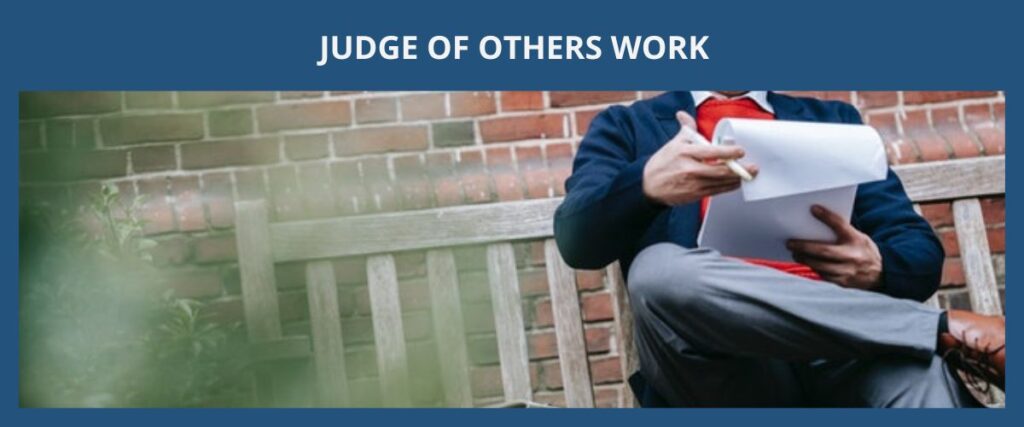
Effective and Qualifiable Items (Judge of Other People's Work)
Below are some general guidelines as to what usually satisfies the “judge of other people’s work” criterion under an EB1a green card petition.
- Academics and researchers can be seen as a judge of other people’s work by peer-reviewing manuscripts for scholarly journals, serving on editorial review boards, and reviewing proposals for reputable organizations such as the National Science Foundation or the National Institutes of Health. Expert review work for journals that have international circulations will be given substantial weight. The quality, quantity, reputation of where the review work is published (e.g., scholarly journal) will be considered in totality.
- Serving on a Ph.D. graduate dissertation committee that makes final judgments on the satisfaction of the degree requirements may be qualifiable.
- Reviewing theses, reviewing conference papers, serving as conference chair, and reviewing for significant research grants that are given to various scientific fields may be qualifiable.
- Serving on a national panel of experts to evaluate the work of other established professionals, being an expert on a jury for a juried art show, or a medical doctor judging the work of other medical professionals can be qualifiable.
- Invited judges for contests, sporting events, artistic showcases, and music or film festival juries can be qualifiable. For example, serving as a judge on the Emmys panel.
Non-Effective Items (Judge of Other People’s Work)
Below are some general guidelines as to what items are usually considered non-effective or less-effective in satisfying the “judge of other people’s work” criteria under an EB1a green card petition.
- A referee does not necessarily equate to being a judge of other people’s work. For example, being a referee of a kickboxing contest does not qualify as serving as a judge of others’ work because it does not show the person exercising judgment in choosing the ultimate winner of the competition.
- The review work cannot be a part of the person’s inherent job duties, such as a professor evaluating a student’s work as an instructor or a chief resident evaluating medical residents as a supervisor.
Documents to Prepare (Judge of Other People's Work)
Commonly used documents to prove that a person has served as a judge of others work under an EB1a green card petition includes but is not limited to:
- A confirmation letter from the organization that invited the person to serve as a judge should include details such as who chose the person to become a judge, the selection criteria and process of choosing the judges, the reasons of why the person was chosen, examples of prior judges who are highly acclaimed in the field, the dates of when the person served as a judge, the details of the work and the level of expertise of those who were being judged, and documents that show the assessments made by the person while serving as a judge. The person’s expertise and reputation should be the main reason why they were chosen to serve as a judge.
- Documents that show what criteria the person used when reviewing other people’s work as a judge.
- Documents that show the significance of the work that was judged by the person.
- Documents (e.g., official organizational documents or bylaws) that show the criteria used to select judges.
- Documents that log the appearances of the review work.
The person has produced original scientific, scholarly, artistic, athletic, or business-related contributions that have major significance in their area of expertise.
One criterion that proves the person has extraordinary ability under the EB1a green card petition requires the person to have made original scientific, scholarly, artistic, athletic, or business-related contributions that have major significance to their professional field.
The two parts that need to be satisfied under this criterion of the EB1a green card petition are: the contribution must be (1) original and have (2) major significance to their area of expertise.
The emphasis in this criterion is on whether the person’s contribution had a major significance to their field of expertise because there are usually no problems with showing that the contribution is original. Major significance can usually be shown by sparking demonstrable change in the field of expertise or if the work has been used or cited by a large number of independent people. For example, a researcher of theoretical cosmology pointed out flaws in a widely accepted theory in the field which sparked fierce debate among the theoretical cosmologists.
It is important to have an independent source stating that the person made a major contribution in their field of expertise in a manner that can be easily understood by the immigration officer. For example, an article in the Journal of Virology published an explicit statement about the person’s discovery of a new strain of virus making a major impact in the field of virology would be easy to understand and hard to dispute.
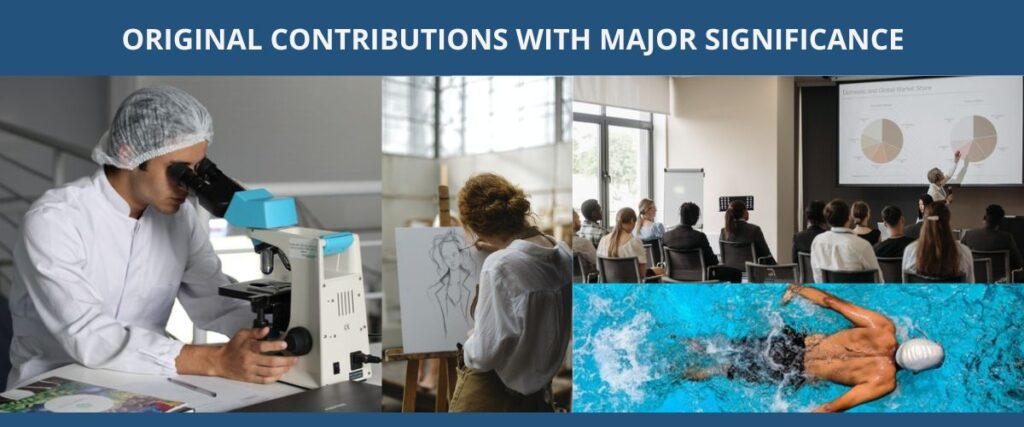
Effective and Qualifiable Items (Original Contributions with Major Significance)
Below are some general guidelines as to what usually satisfies the “original contributions that have major significance to the field of expertise” criterion under an EB1a green card petition.
- Major contributions can be when the person’s work has been widely used, adopted, cited, or used by independent peers, other people gained national or international recognition in the field building on the person’s contribution, or the person’s work sparked significant debate or demonstrable change in the field. For example, an insect researcher discovered 96 new species of spiders which represented 10% of the documented information on that spider family would be considered showing a measurable increase to the current body of scholarship.
- For athletes, contributions may be shown by being selected to be on an all-star team or a national team to compete on an international level, and the person’s performance statistics and rankings. For example, a hockey player who has outstanding plus/minus performance statistics and has been ranked as the fifth best enforcer in the National Hockey League was selected to play on Team Canada in an international hockey tournament.
- For artists, contributions may be shown by their work being displayed in major national or international exhibitions, receiving awards, published albums of their work, media coverage or critical reviews that state the content or style of the person’s work as original and significant to their field of expertise.
- For people in business, contributions may be shown by the person closing major business deals, receiving industry awards for their outstanding achievements, and being selected to join prestigious business associations. For example, a wine distributor closed a major business deal that won the person an international award and led the person to be invited to join the prestigious Wines of South Africa Importers Committee where the person helped increase the import of South African wines to the United States by 45 percent.
- Patents must be approved and it must be shown that the patent has impacted the field substantially. For example, the patented invention has been manufactured, widely used, licensed to others, and commercially successful.
Non-Effective Items (Original Contributions with Major Significance)
Below are some general guidelines as to what items are usually considered non-effective or less-effective in satisfying the “original contributions that have major significance to the field of expertise” criterion under an EB1a green card petition.
- General statements of the contribution’s importance are not effective.
- Merely showing the work was funded, published, or original is not enough. It must show that it has major significance in the field of expertise.
- The work must be already used or replicated by independent researchers and not just by the person’s colleagues. For example, a patented tool that was only used in the organization of the person’s employment may be seen as too localized and thus not considered significant for the field as a whole.
Documents to Prepare (Original Contributions with Major Significance)
Commonly used documents to prove that a person has made original contributions that have major significance to their area of expertise under an EB1a green card petition includes but is not limited to:
- Letters and testimonies from established and reputable professors, colleagues, editors, researchers from a national laboratory, or the public office must include details of the person’s contribution and an explanation of how the person’s work is “original” (not replicating other people’s work) and why it has “major significance” in the field.
- Recommendation letters from independent experts in the field of expertise are the most effective since it is deemed as more impartial. Independent experts are those that are outside of the person’s colleagues and acquaintances. The letters should detail the usage of the person’s work and the influence the work has on others in the field.
- Recommendation letters from Venture Capitalists or CEO/founders should describe in detail the person’s achievements in the field and how the achievements have major significance in the field.
- Media coverage of the major contributions can be from scientific or academic press within the community or news outlets for the general public. For example, an article in the Washington Post discussing the person breaking new scientific grounds by discovering a new strain of virus and is developing a new vaccine to combat the new strain of virus can be qualifiable evidence.
- Documents that can objectively show the significance of the contribution to the field, that people in the field currently believe that the persons work is important, that it has sparked widespread public commentary or change in the field, or that the work has been widely cited or used by others. For example, objective documents such as contracts that detail the person’s products are being used by multiple companies, licensing agreements showing the technology is used by others, and records of the patented inventions being manufactured and sold to clients.
- When the person’s business is based primarily online, the website usage or website visitor traffic, number of people that have purchased and/or downloaded the product(s) or application(s), evidence that the product or application has made original contributions of major significance to their field must be provided.
The person's authorship of scholarly articles is shown in professional or major trade publications, or in other major media publications.
One criterion that proves the person has extraordinary ability under the EB1a green card petition requires the person to have authored scholarly articles that are published in professional or major trade publications, or in other major media publications (e.g., national newspapers, magazines).
Scholarly articles under the EB1a green card petition are articles that include content such as philosophical discourses, reports on original researches, and experimentation results that are specifically written for learned persons (i.e., persons who have profound knowledge or scholarship) in the field. The emphasis of this criterion under the EB1a green card petition is that scholarly articles must be peer-reviewed or cited by others.
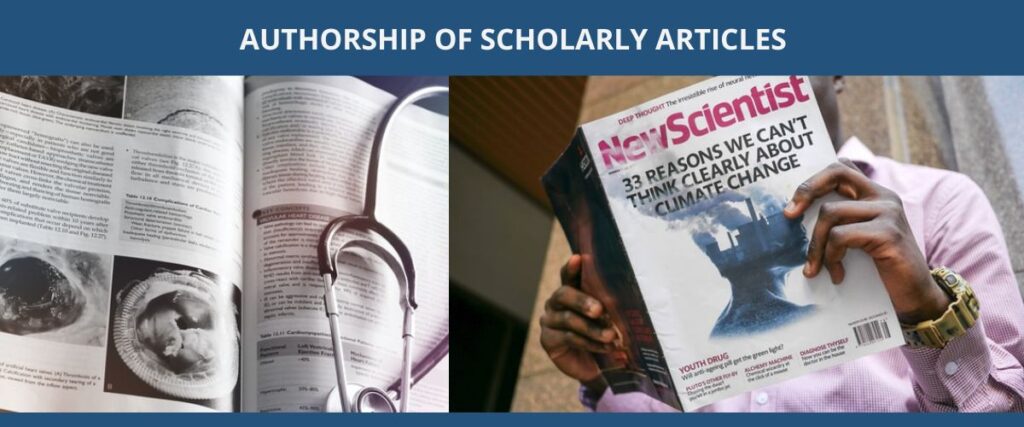
Effective and Qualifiable Items (Authorship of Scholarly Articles in Professional/Major Trade/Major Media)
Below are some general guidelines as to what usually satisfies the “authorship of scholarly articles in professional or major trade publications, or major media publications” criteria under an EB1a green card petition.
- The scholarly article should be cited or peer-reviewed. The number of citations of the person’s scholarly articles will be taken into account but the quality is more important than the quantity here.
- Scholarly articles that are published in peer-reviewed reputable journals with national or international circulation are considered most effective.
- The person being the only author or the first author is usually more effective than the person being one of many authors (and not being listed first). When more than one author is listed, how the person contributed in the research effort would need to be explained.
- The person’s work can be published in a conference setting.
- The scholarly article should be primarily created by the person.
Non-Effective Items (Authorship of Scholarly Articles in Professional/Major Trade/Major Media)
Below are some general guidelines as to what items are usually considered non-effective or less-effective in satisfying the “authorship of scholarly articles in professional or major trade publications, or major media publications” criteria under an EB1a green card petition.
- Scholarly articles that are published in non-peer-reviewed publications, vanity presses, or regional publications are not effective.
- Scholarly articles that have not been cited or peer-reviewed are not effective.
- Articles that are not considered scholarly articles cannot be used. Non-scholarly articles are articles that were not specifically written for learned persons (i.e., persons who have profound knowledge or scholarship) in the field to read.
- Inconsistent and declining publication records may show a lack of sustained acclaim even if the person had prolific publications in prior years.
Documents to Prepare (Authorship of Scholarly Articles in Professional/Major Trade/Major Media)
Commonly used documents to prove that the person has authorship of scholarly articles in professional or major trade publications, or major media publications under an EB1a green card petition includes but is not limited to:
- The citation records can be provided by copies of citation indexes, displaying the number of citations, and the titles of the articles that cited the person’s work. Full articles of all citations do not need to be provided.
- The record of scholarly articles can be provided by results from scholarly literature search websites (e.g., SciFinder, Google Scholar) or paper copies of the person’s articles that show the person as the author, the title of the article, and the journal it was published in.
- Documents that include information such as the significant impact the person’s scholarly article has in their field of expertise, the date it was published, the number of copies printed for circulation, the frequency of the publication, and the targeted readership of the publication should be provided.
- Documents that show the person’s publications have a significant impact in their field of expertise can include but is not limited to a university or college course syllabi that lists the person’s publications as required reading, examples of international conferences featuring the person’s publications, expert letters and testimonials, and published reviews that are favorable to the person’s publications.
- Documents that show the selectiveness and prestige of the journal that published the person’s work should include information such as the ranking of the publication or the impact factor of the publication.
- Documents that show the significance of the publications that are published in conferences should include information such as the attendance numbers, brand-name conference sponsors, examples of other well-known people who also presented work at the conference, and the selection criteria and process in picking presenters for the conference.
- The scholarly article should be submitted in the same media format in which it was published. For example, a photocopy of the printed article should be provided if the article was originally published in print or a PDF print-out from the website should be provided if the article was originally published online.
The person's work has been displayed at artistic exhibitions or showcases.
One criterion that proves the person has extraordinary ability under the EB1a green card petition requires the person to show that their work has been displayed at artistic exhibitions or showcases in the past.
The person’s work must have been shown at a venue (i.e., a physical or virtual place where an event is happening) that is artistic in nature. For example, a painter’s oil painting being displayed at an art exhibition in a museum, a musician playing their song in a live concert, a lyricist’s lyric being performed in a live musical performance, a writer’s script being performed in a stage play, or a fashion designer’s sneaker design being shown in a fashion show.
The emphasis in this EB1a green card petition criterion is that the venue (i.e., a physical or virtual place where an event is happening) of the display should be considered prestigious and the person’s role must be significantly central. For example, an opera singer served as the leading vocalist (i.e., important role) in a high-profile performance that took place at the Royal Opera House (i.e., prestigious venue).

Effective and Qualifiable Items (Work Displayed at Artistic Exhibitions or Showcases)
Below are some general guidelines as to what usually satisfies the “work displayed at artistic exhibitions or showcases” criterion under an EB1a green card petition.
- The work must be primarily created by the person and the person’s work should be central to the artistic exhibition or showcase. For example, an actor playing a leading role in a stage play.
- For performing artists, the work should be able to consistently attract a substantial amount of audience on a national or international level. For example, a comedian having multiple sold-out shows during their annual European tour.
- For work where visual display is not possible, comparable evidence is allowed to show that their work is being displayed. For example, a composer and lyricist can satisfy this criterion by showing that their music was performed in live concerts.
Non-Effective Items (Work Displayed at Artistic Exhibitions or Showcases)
Below are some general guidelines as to what items are usually considered non-effective or less-effective in satisfying the “work displayed at artistic exhibitions or showcases” criterion under an EB1a green card petition.
- Performing solo does not necessarily show sustained acclaim or extraordinary ability.
- An artistic exhibition or showcase that shows low sale records for tickets or that it has failed to attract a large audience will be ineffective evidence.
- Serving as a supporting role in the artistic exhibition or showcase is ineffective evidence. For example, secondary roles in a fashion show could be the staff who provide basic sound and lighting or the security personnel for the show.
- Work that is displayed at a prestigious exhibition or showcase may not be effective if the person’s overall contribution is considered very minor.
- Presentations at conferences cannot be used here.
Documents to Prepare (Work Displayed at Artistic Exhibitions or Showcases)
Commonly used documents to prove that a person has work displayed at artistic exhibitions or showcases under an EB1a green card petition includes but is not limited to:
- Media coverage of the events that show the exhibition or showcase is well-known on a national or international level.
- Documents that show the work was created by the person, such as sale records that list the person as the creator of the sold works, or published promotional materials of the person’s artistic work.
- Documents that can show the prestige of the exhibition or showcase, such as catalogs, pictures, official published material from the organization of the exhibition, brochures, programs, critical reviews, and media coverage of the event.
- Documents that show the exclusiveness of the exhibition or showcase should include information such as the selection criteria for the work chosen, the number of artists that competed for the selection and the number of artists that were chosen, and examples of other participating artists who are well-known on a national or international level.
- Published material that shows the participation of people who are at the top of the person’s field of expertise can be effective evidence. For example, the attendance of Anna Wintour or other well-known celebrities at a fashion show can indicate the degree of prestige the event has.
The person has performed in a leading or critical role for distinguished organizations or establishments.
One criterion that proves the person has extraordinary ability under the EB1a green card petition requires the person to have served in a leading or critical role for a distinguished organization or establishment.
The person under this criterion must have been in a leading or critical role for an organization (or establishment) that has a distinguished reputation or has recently hosted productions that have distinguished reputations.
The emphasis of this EB1a green card petition criterion is the impact that the person’s role had on the organization. For example, a marketing researcher working for a business university was endorsed by the director of the university with the statement that the person expanded the school’s visibility which helped build up the reputation of the school as a standout institution in the business and management training field.
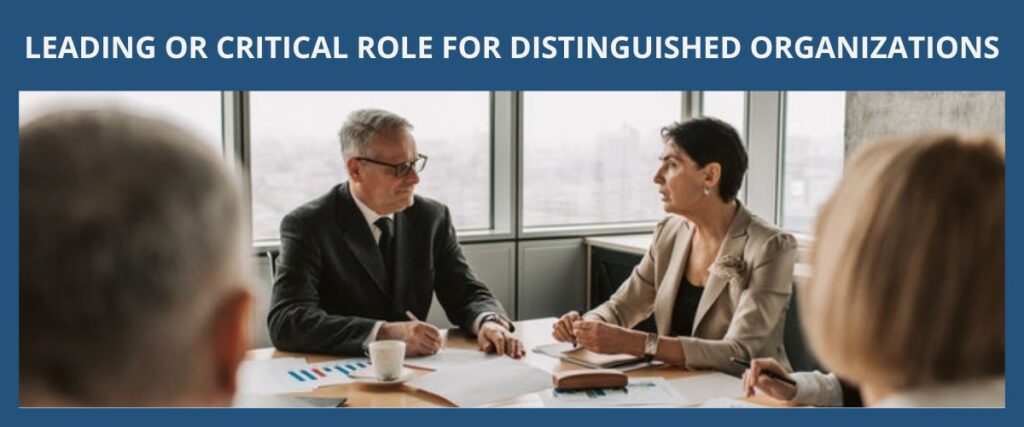
Effective and Qualifiable Items (Leading or Critical Role for Distinguished Organizations/Establishments)
Below are some general guidelines as to what usually satisfies the “leading or critical role for distinguished organizations or establishments” criterion under an EB1a green card petition.
- The leading or critical role should be for the organization as a whole and not for one division or department unless that division or department is critical to the overall success of the organization.
- A leading or critical role could be that the person founded the organization, established a critical department in the organization, executed a key program that led the organization to success, or the performance of the person increased the organization’s popularity or enhanced the organization’s reputation.
- Leading and critical roles can be positions such as chief executive officer (CEO), vice president (VP), a member of the Board of Directors, and team captain of a national sports team.
- A critical role should be one where the person’s contribution played a significant impact on the outcomes of the activities of the organizations or establishments.
- A critical role can include a supporting role if the person’s performance in that role was significantly impactful enough to the organization or establishment.
Non-Effective Items (Leading or Critical Role for Distinguished Organizations/Establishments)
Below are some general guidelines as to what items are usually considered non-effective or less-effective in satisfying the “leading or critical role for distinguished organizations or establishments” criterion under an EB1a green card petition.
- Simply performing well in a job position and having a good reputation among coworkers, or being selected for a competitive job position in itself alone are not necessarily effective here.
- The person having the same or similar title as other people in the organization would not be effective unless it is shown that the person’s role is different and more distinguished when compared to others.
- Simply doing speaking engagements with distinguished organizations or establishments is not effective.
- Simply performing a leading role in a project or production is not enough, the project or production must be successful as well.
- Being considered for major projects or roles in the future cannot be used here because this criterion must be satisfied at the time of filing the EB1a green card petition.
- If the person’s role in the organization does not have a demonstrable impact beyond the organization itself (which happens more frequently in private companies), it would be considered ineffective evidence.
Documents to Prepare (Leading or Critical Role for Distinguished Organizations / Establishments)
Commonly used documents to prove that a person has performed in a leading or critical role for distinguished organizations or establishments under an EB1a green card petition includes but is not limited to:
- Documents that show the organization or establishment has a distinguished reputation should include information such as industry rankings, media coverage of the organization or the organization’s work, awards that the organization has received, and expert letters that attest to the organization as having a distinguished reputation.
- Documents that show the person was in a leading role for the organization or establishment should include information such as appropriate titles with matching duties, media coverage of the person’s performance in the leading role, organizational charts that show the person’s position as leading, and the selection process for the person’s position.
- Documents that show the person was in a critical role for the organizations or establishments.
- Media coverage that shows the importance of the person to the organization or what the person has achieved for the organization.
- Expert letters that explain the nature and the importance of the person’s role in the organization.
- Documents that show the person’s ranking or performance statistics are commonly used for athletes, such as the plus-minus ratio for a hockey player.
- Letters from people who have personal knowledge on how the person’s leading or critical role significantly impacted the organization or establishment should be provided. The content of the letters should be able to verify and explain in detail the person’s role and include a comparison of the specific tasks or achievements of the person and others who have similar jobs in the field.
The person receives a high salary or remuneration when compared to what other workers in similar positions usually receive in the same field.
One criterion that proves the person has extraordinary ability under the EB1a green card petition requires the person to have the ability to receive a higher salary or remuneration than other similar workers in their professional field.
The person’s salary or remuneration must be considered high when compared to what others in the same field usually receive. Generally, it should be at or above the 90th percentile in the comparable salary scales. The emphasis of this criterion in the EB1a green card petition is the comparison to others in similar circumstances.
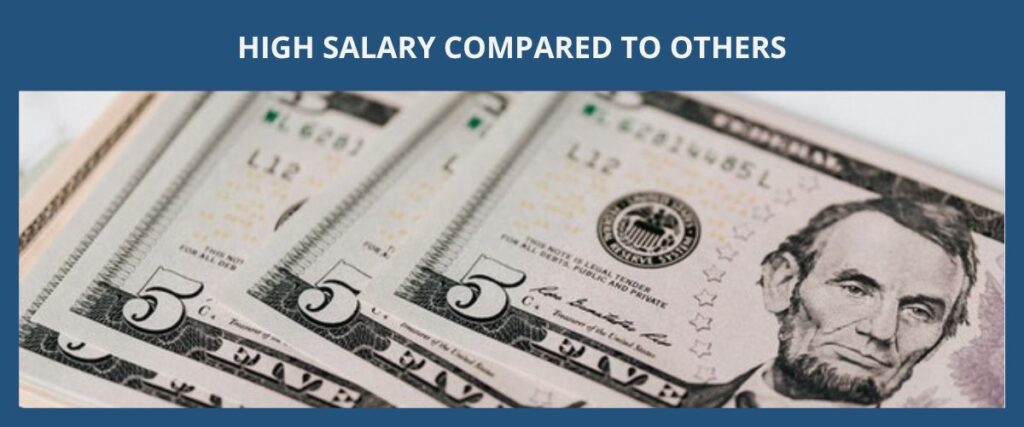
Effective and Qualifiable Items (High Salary or Remuneration Compared to Others)
Below are some general guidelines as to what usually satisfies the “high salary or remuneration compared to others” criterion under an EB1a green card petition.
- The comparable salary scale can be data from the United States or a foreign country depending on where the person was working at the time. For example, the person’s salary can be considered very high in Taiwan but low in the United States and still be qualified because the standard is how the person’s salary compare to others in similar circumstances.
- The salary should be at or above the 90th percentile of comparable salary scales.
- The person’s salary must be high when compared to others who have similar levels of experience working in a comparable position within the same geographical location. For example, the person’s salary may be at the 90th percentile in the salary scale of the Chicago area but only at the 70th percentile in the San Francisco area.
- Bonuses may qualify as a part of the remuneration if the person has actual receipt of the bonuses and it is included in the total wages section of the tax return.
Non-Effective Items (High Salary or Remuneration Compared to Others)
Below are some general guidelines as to what items are usually considered non-effective or less-effective in satisfying the “high salary or remuneration compared to others” criterion under an EB1a green card petition.
- Salary that is considered high to an average person but is low when compared to other similar workers in the person’s field of expertise would not be considered effective evidence.
- Benefits (i.e. tuition reimbursements, healthcare allotments, profit-sharing incentives, stock options, 401(k) contributions, etc.) are not considered effective evidence.
Documents to Prepare (High Salary or Remuneration Compared to Others)
Commonly used documents to prove that the person receives a high salary or remuneration when compared to what other workers in similar positions usually receive in the same field under an EB1a green card petition includes but is not limited to:
- Salary or remuneration records in the form of official government tax returns (e.g., Form W-2, Form 1099, or foreign equivalent).
- Annual income statements, monthly pay stubs, payroll records, bank transaction statements, and the accountant’s letter of support can be submitted.
- Media coverage of notable high salaries earned by others in the person’s field of expertise can be submitted.
- Compiled lists of top earners in the person’s field of expertise by credible professional organization(s) that include information such as salary or earning rankings can be submitted.
- Geographical or position appropriate compensation surveys, such as average salary scales of the person’s position in the industry, of the foreign country where the person earned their salary, or of the state where the person earned their salary in the United States can be submitted.
- Documents that show the organizational justifications to pay above the compensation data can be submitted.
Commercial success in the performing arts (e.g., box office receipts, sale records).
One criterion that proves the person has extraordinary ability under the EB1a green card petition requires the person to show that they have achieved commercial success in the performing arts in the past (i.e., made a large amount of money with their artistic work).
The emphasis in this EB1a green card petition criterion is on how high the monetary gain was and how close was the person associated with the cause of that commercial success. For example, the person as the lead singer of a band can be directly attributable to the high-grossing high-volume ticket sales of the band’s North American tour.
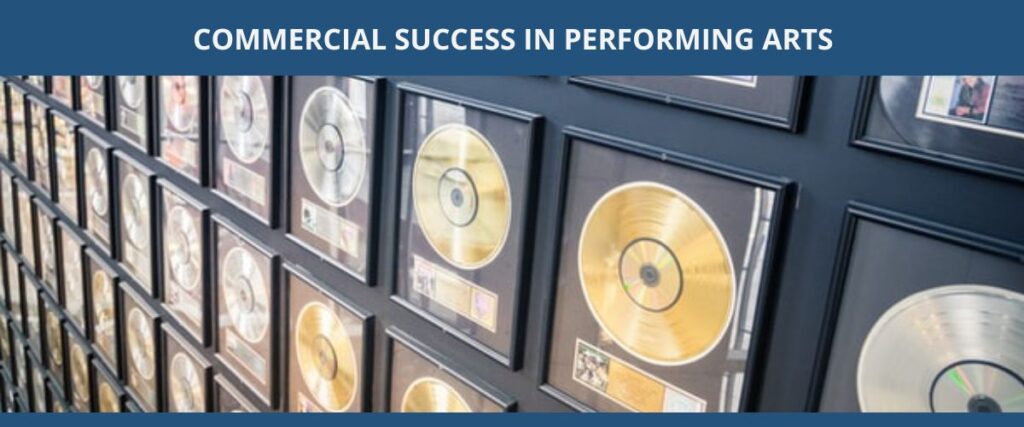
Effective and Qualifiable Items (Commercial Success in Performing Arts)
Below are some general guidelines as to what usually satisfies the “commercial success in the performing arts” criterion under an EB1a green card petition.
- Commercial success is usually shown by the attendance of a large audience or high-volume sales revenues. For example, high-volume numbers in box office receipts and sale receipts of audio or video recordings can be effective evidence.
- The commercial success should also be relatively better than others that are involved in similar work.
- Supporting factors that show commercial success can include but are not limited to consistent attraction of large audiences, regularly sold-out performances, having larger audiences compared to other similar performances, videos with high-volume national or international sales, and the performance being displayed at a prestigious venue (e.g., Broadway, Madison Square Garden).
- The person must be associated closely enough with the cause of the commercial success. For example, the lead actor in a popular movie, the drummer or bass player in a chart-topping band, or the sound engineer who mixed the band’s platinum-selling album may also be close enough because there is a direct contribution to the album’s commercial success.
- Authors of commercially successful performing art productions can qualify. For example, an author of a best-selling book that has been adapted into a television series.
Non-Effective Items (Commercial Success in Performing Arts)
Below are some general guidelines as to what items are usually considered non-effective or less-effective in satisfying the “commercial success in the performing arts” criterion under an EB1a green card petition.
- The mere fact that the person has recorded and released musical compilations or performed in movies, television shows, and theatrical plays in itself alone would not be enough.
- List of reputable international organizations broadcasting or using the person’s work in itself alone is not necessarily effective here.
- It is usually hard to show that a person who is a subordinate or supporting member of a group is the cause of commercial success. For example, brief participation in a commercially successful ensemble will not be effective evidence.
- General statements on commercial success are not effective. For example, a letter from a general manager of a ticket sales outlet stating that a choreographed dance play was sold out on its initial run was not considered a commercial success.
Documents to Prepare (Commercial Success of Performing Arts)
Commonly used documents to prove commercial success in the performing arts under an EB1a green card petition includes but is not limited to:
- Documents that show commercial success are usually in the form of sales or receipts, such as high-volume box office receipts and high-volume audio sales or video sales.
The overall emphasis on the documents and requirements/criteria of an EB1a green card petition is that the person’s caliber at a national or international level must be shown. For example, the requirement that the person must have sustained national or international acclaim or the criterion that requires scholarly articles to have been published in journals that have national or international circulation.
The requirements for an EB1a green card petition are extensive and while ticking the boxes of requirements sounds simple enough, figuring out what items should be included and strategizing how the petition is presented is not. It is common practice and strongly encouraged to obtain an attorney for employment-based green card petitions.
For people who do not qualify for the EB1a green card petition yet, the closest alternative would be filing a National Interest Waiver (NIW) with an EB2 green card petition. The EB2 National Interest Waiver green card petition would require the person to have at least a master’s degree (or its equivalent) or have exceptional ability (lower standard than the extraordinary ability in the EB1a green card petition) in the sciences, arts, or business, and the person would also need to show that their work will be able to benefit the United States significantly.
Other alternatives would be the more commonly used employment-based green card petitions such as the regular EB2 green card petitions (Advanced Degree) and the EB3 green card petitions (Professional, Skilled, Other Workers). These types of employment-based green card petitions usually require a sponsoring U.S. employer and a PERM Labor Certification.
If you have an EB1a green card (Alien of Extraordinary Ability) immigration question, please fill out our contact us form or send us an email with some basic information about your background and your immigration needs. We will do our best to respond within 48 hours.
How we can help?
Kylie Huang Law’s immigration attorney will help identify whether the EB1a green card is the appropriate immigrant visa category for the client’s professional background. We will work closely with our client to prepare a convincing case for their EB1a green card petition and we will also strategize on how the EB1a green card petition should be presented to achieve the best chances of approval. It is strongly advised and common practice to retain an immigration attorney for an EB1a green card petition due to the complexities in the immigration process and visa requirements.
What does the typical process look like to retain (hire) us?
- Step 1:
- Step 2:
- Step 3:
- Step 4:
- Step 5:
- a.
- b.
- c.
- Step 6:
- Step 7:
- Step 8:
- Fill out the form (with some basic information on what your immigration needs are)
- Sign up and log into the client portal to schedule an appointment online
- Attend scheduled appointment (typically a phone call or zoom meeting)
- Retainment (signing a contract to hire us)
- Start processing case
- Gathering required documents
- Preparing paperwork
- Confirming contents of documents that will be submitted
- Filing the case
- Following up on the status of the case
- Close the case when a final determination is issued
- Step 1:
- Step 2:
- Step 3:
- Step 4:
- Step 5:
- a.
- b.
- c.
- Step 6:
- Step 7:
- Step 8:
- Fill out the form (on what your immigration needs are)
- Sign up and log into the client portal to schedule an appointment
- Attend scheduled appointment (typically a phone call or zoom)
- Retainment (signing a contract to hire us)
- Start processing case
- Gathering required documents
- Preparing paperwork
- Confirming contents of documents that will be submitted
- Filing the case
- Following up on the status of the case
- Close the case when a final determination is issued
- Step 1:
- Step 2:
- Step 3:
- Step 4:
- Step 5:
- a.
- b.
- c.
- Step 6:
- Step 7:
- Step 8:
- Fill out the form (on what your immigration needs are)
- Sign up and log into the client portal to schedule appointment
- Attend scheduled appointment (typically a phone call or zoom)
- Retainment (hire us)
- Start processing case
- Gathering required documents
- Preparing paperwork
- Confirming content of documents that will be submitted
- Filing the case
- Following up on the case status
- Close the case when a final determination is issued

